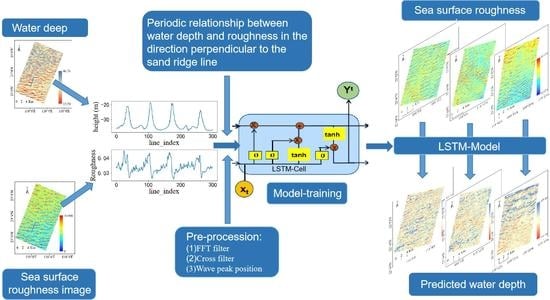LSTM-Based Remote Sensing Inversion of Largescale Sand Wave Topography of the Taiwan Banks
Abstract
:1. Introduction
2. Study Area Profile and Dataset
2.1. Study Area
2.2. Dataset
2.3. Sand Wave Terrain Feature Analysis
3. Models and Methods
3.1. Methods Flow
3.2. Preprocessing of Data
3.2.1. Roughness Filtering
3.2.2. Sand Wave Crest Position Characteristics
3.3. Construction of Inverse Models Based on LSTM Networks
3.3.1. LSTM Networks
- Forget Gate:
- 2.
- Input Gate:
- 3.
- Output Gate:
- 4.
- Input Node:
- 5.
- Cell State:
- 6.
- Hidden Gate:
3.3.2. Training of LSTM Networks
- (1).
- Two-dimensional images were transformed into one-dimensional images. To simulate continuously changing time streams, we connected the profile lines perpendicularly to the sand ridgeline according to the head and tail of the column. Correspondingly, we connected the topographic data head to tail along the profile lines. At this point, the two-dimensional image was converted into a one-dimensional continuous sequence of data.
- (2).
- Data normalization: The LSTM model learned the relative trends of two sequences, and, therefore, the Xt and yt data needed to be normalized. Their means were subtracted from both, and they were divided by the variance to obtain the final data set. The normalized depth value of the region was obtained by subtracting water depth data from the mean and dividing it by the variance.
- (3).
- Network initialization: The weights (W) and bias vector (b) were set to 0 at initialization. hidden_size was set to indicate the number of hidden layer storage block dimensions. The mid layer was set to indicate the number of hidden layers contained in the network. L indicated the input window length, and Lr indicated the step length of each random gradient descent.
- (4).
- Data partitioning: The dataset was divided into a training set Xtr = {X1,X2,… Xd} and a test set Xte′ = {Xd+1, Xd+2,…, Xn}. The training set was a subset organized according to the window length L. Each subset obtained was called a batch and was counted as {Xtr1,Xtr2,…,Xtrt,…,Xtrd-L+1}, where Xtrt = {Xt,Xt+1,…,Xt+L−1} is the primary input to the LSTM network, and its corresponding output is {ht,ht+1,…,ht+L−1}, which is counted as an epoch according to the number of rounds of the network iteration.
- (5).
- The key steps in training the LSTM model are presented in Algorithm 1.
| Algorithm 1: LSTM model iteration |
| Require: the initial value of W and b, number of hidden layers mid_layer, number of hidden layer storage block dimensions hidden_size, input window length L. for k = 1, 2,…Epoch do for t = 1,2,d + L − 1 do Calculate ft Get output ht end for Error calculation: E = (ht − yt)2 Calculate the Mean Square Error between the node output and the true value Node parameter update: Update W and b based on the error term E using the Adam gradient optimization algorithm. end for |
3.4. Validation and Application
4. Model Evaluation and Application
4.1. Model Evaluation
4.2. Model Application
5. Discussion
5.1. Errors at Different Depths
5.2. Errors at Different Wavelengths
5.3. Sensitivity to the Size of the Training Dataset
5.4. Strengths and Weaknesses of the Method
6. Conclusions
Author Contributions
Funding
Institutional Review Board Statement
Informed Consent Statement
Data Availability Statement
Conflicts of Interest
References
- McCave, I.N. Sand waves in the North Sea off the coast of Holland. Mar. Geol. 1971, 10, 199–225. [Google Scholar] [CrossRef]
- Park, S.C.; Lee, S.D. Depositional patterns of sand ridges in tide-dominated shallow water environments: Yellow Sea coast and South Sea of Korea. Mar. Geol. 1994, 120, 89–103. [Google Scholar] [CrossRef]
- Barnard, P.L.; Hanes, D.M.; Rubin, D.; Kvitek, R.G. Giant sand waves at the mouth of San Francisco Bay. Eos 2006, 87, 285–289. [Google Scholar] [CrossRef]
- Zhou, J.; Wu, Z.; Jin, X.; Zhao, D.; Cao, Z.; Guan, W. Observations and analysis of giant sand wave fields on the Taiwan Banks, northern South China Sea. Mar. Geol. 2018, 406, 132–141. [Google Scholar] [CrossRef]
- Wang, Y.; Liu, Y.; Jin, S.; Sun, C.; Wei, X. Evolution of the topography of tidal flats and sandbanks along the Jiangsu coast from 1973 to 2016 observed from satellites. ISPRS J. Photogramm. Remote Sens. 2019, 150, 27–43. [Google Scholar] [CrossRef]
- Katoh, K.; Kume, H.; Kuroki, K.; Hasegawa, J. The Development of Sand Waves and the Maintenance of Navigation Channels in the Bisanseto Sea. Coast. Eng. 1999, 1. [Google Scholar] [CrossRef]
- Morelissen, R.; Hulscher, S.J.; Knaapen, M.A.; Németh, A.A.; Bijker, R. Mathematical modelling of sand wave migration and the interaction with pipelines. Coast. Eng. 2003, 48, 197–209. [Google Scholar] [CrossRef]
- Zhang, H.G.; Yang, K.; Lou, X.L.; Li, D.L.; Shi, A.Q.; Fu, B. Bathymetric mapping of submarine sand waves using multi-angle sun glitter imagery: A case of the Taiwan Banks with ASTER stereo imagery. J. Appl. Remote Sens. 2015, 9, 095988-1–095988-13. [Google Scholar] [CrossRef] [Green Version]
- Lee, Z.; Hu, C.; Casey, B.; Shang, S.; Dierssen, H.; Arnone, R. Global Shallow-Water Bathymetry From Satellite Ocean Color Data. Eos 2010, 91, 429–430. [Google Scholar] [CrossRef] [Green Version]
- Fan, K. Remote sensing of SAR shallow sea topography based on sea surface microwave scattering imaging. Acta Geod. Cartogr. Sin. 2010, 39, 329. [Google Scholar]
- Liu, Z.C.; Zhou, X.H.; Chen, Y.L.; Hu, G.H. The development in the latest technique of shallow water multi-beam sounding system. Hydrogr. Surv. Charting 2005, 6, 21. [Google Scholar]
- Catalao, J.; Nico, G. Multitemporal Backscattering Logistic Analysis for Intertidal Bathymetry. IEEE Trans. Geosci. Remote Sens. 2017, 55, 1066–1073. [Google Scholar] [CrossRef]
- Alpers, W.; Hennings, I. A theory of the imaging mechanism of underwater bottom topography by real and synthetic aperture radar. J. Geophys. Res. Space Phys. 1984, 89, 10529–10546. [Google Scholar] [CrossRef]
- Calkoen, C.J.; Hesselmans, G.; Wensink, G.J.; Vogelzang, J. The bathymetry assessment system: Efficient depth mapping in shallow seas using radar images. Int. J. Remote Sens. 2001, 22, 29732998. [Google Scholar] [CrossRef]
- Weigen, H.; Bin, F. A spaceborne SAR technique for shallow water bathymetry surveys. J. Coastal Res. 2004, 43, 223–228. [Google Scholar]
- Hennings, I.; Doerffer, R.; Alpers, W. Comparison of submarine relief features on a radar satellite image and on a Skylab satellite photograph. Int. J. Remote Sens. 1988, 9, 45–67. [Google Scholar] [CrossRef]
- Cox, C.; Munk, W. Measurement of the Roughness of the Sea Surface from Photographs of the Sun’s Glitter. J. Opt. Soc. Am. 1954, 44, 838–850. [Google Scholar] [CrossRef]
- Hennings, I.; Matthews, J.; Metzner, M. Sun glitter radiance and radar cross-section modulations of the sea bed. J. Geophys. Res. Space Phys. 1994, 99, 16303–16326. [Google Scholar] [CrossRef]
- Shao, H.; Li, Y.; Li, L. Sun glitter imaging of submarine sand waves on the Taiwan Banks: Determination of the relaxation rate of short waves. J. Geophys. Res. Space Phys. 2011, 116, 06024. [Google Scholar] [CrossRef] [Green Version]
- He, X.; Chen, N.; Zhang, H.; Fu, B.; Wang, X. Reconstruction of sand wave bathymetry using both satellite imagery and multi-beam bathymetric data: A case study of the Taiwan Banks. Int. J. Remote Sens. 2014, 35, 3286–3299. [Google Scholar] [CrossRef]
- Liu, S.; Wang, L.; Liu, H.; Su, H.; Li, X.; Zheng, W. Deriving Bathymetry from Optical Images with a Localized Neural Network Algorithm. IEEE Trans. Geosci. Remote Sens. 2018, 56, 5334–5342. [Google Scholar] [CrossRef]
- Alevizos, E. A Combined Machine Learning and Residual Analysis Approach for Improved Retrieval of Shallow Bathymetry from Hyperspectral Imagery and Sparse Ground Truth Data. Remote Sens. 2020, 12, 3489. [Google Scholar] [CrossRef]
- Panagiotis, A.; Konstantinos, K.; Georgopoulos, A.; Skarlatos, D. Correcting image refraction: Towards accurate aerial image-based bathymetry mapping in shallow waters. Remote Sens. 2020, 12, 322. [Google Scholar]
- Xiaorun, L.; Li, X.; Zhang, H.; Wang, J.; Lou, X.; Fan, K.; Shi, A.; Li, D. A Bathymetry Mapping Approach Combining Log-Ratio and Semianalytical Models Using Four-Band Multispectral Imagery Without Ground Data. IEEE Trans. Geosci. Remote Sens. 2020, 58, 2695–2709. [Google Scholar] [CrossRef]
- Sepp, H.; Schmidhuber, J. Unsupervised coding with lococode. In Proceedings of the Artificial Neural Networks—ICANN’97, Lausanne, Switzerland, 8–10 October 1997; pp. 655–660. [Google Scholar]
- Fang, K.; Pan, M.; Shen, C. The Value of SMAP for Long-Term Soil Moisture Estimation with the Help of Deep Learning. IEEE Trans. Geosci. Remote Sens. 2018, 57, 2221–2233. [Google Scholar] [CrossRef]
- Xu, L.; Li, Q.; Yu, J.; Wang, L.; Xie, J.; Shi, S. Spatio-temporal predictions of SST time series in China’s offshore waters using a regional convolution long short-term memory (RC-LSTM) network. Int. J. Remote Sens. 2020, 41, 3368–3389. [Google Scholar] [CrossRef]
- Wang, F.; Chen, Y.; Li, Z.; Fang, G.; Li, Y.; Wang, X.; Zhang, X.; Kayumba, P. Developing a Long Short-Term Memory (LSTM)-Based Model for Reconstructing Terrestrial Water Storage Variations from 1982 to 2016 in the Tarim River Basin, Northwest China. Remote Sens. 2021, 13, 889. [Google Scholar] [CrossRef]
- Zhang, L.; Zhang, Z.; Luo, Y.; Cao, J.; Tao, F. Combining Optical, Fluorescence, Thermal Satellite, and Environmental Data to Predict County-Level Maize Yield in China Using Machine Learning Approaches. Remote Sens. 2019, 12, 21. [Google Scholar] [CrossRef] [Green Version]
- Yu, W.; Wu, Z.Y.; Zhou, J.Q.; Zhao, D.N. Meticulous characteristics, classification and distribution of seabed sand wave on the Taiwan bank. Haiyang Xuebao 2015, 37, 11–25. [Google Scholar]
- Bao, J.; Cai, F.; Shi, F.; Wu, C.; Zheng, Y.; Lu, H.; Sun, L. Morphodynamic response of sand waves in the Taiwan Shoal to a passing tropical storm. Mar. Geol. 2020, 426, 106196. [Google Scholar] [CrossRef]
- Zhang, H.; Yang, K.; Lou, X.; Li, Y.; Zheng, G.; Wang, J.; Wang, X.; Ren, L.; Li, D.; Shi, A. Observation of sea surface roughness at a pixel scale using multi-angle sun glitter images acquired by the ASTER sensor. Remote Sens. Environ. 2018, 208, 97–108. [Google Scholar] [CrossRef]
- Wang, Z. Text emotion detection based on Bi- LSTM network. J. Inf. Comput. Sci. 2020, 3, 129–137. [Google Scholar]
- Karevan, Z.; Suykens, J.A. Transductive LSTM for time-series prediction: An application to weather forecasting. Neural Netw. 2020, 125, 1–9. [Google Scholar] [CrossRef] [PubMed]
- Schmidhuber, J. Deep learning in neural networks: An overview. Neural Netw. 2015, 61, 85–117. [Google Scholar] [CrossRef] [Green Version]
- Wang, X.; Liu, M.; Guan, Y. Image edge detection algorithm based on improved canny operator. Comp. Eng. 2012, 38, 196–198. [Google Scholar]
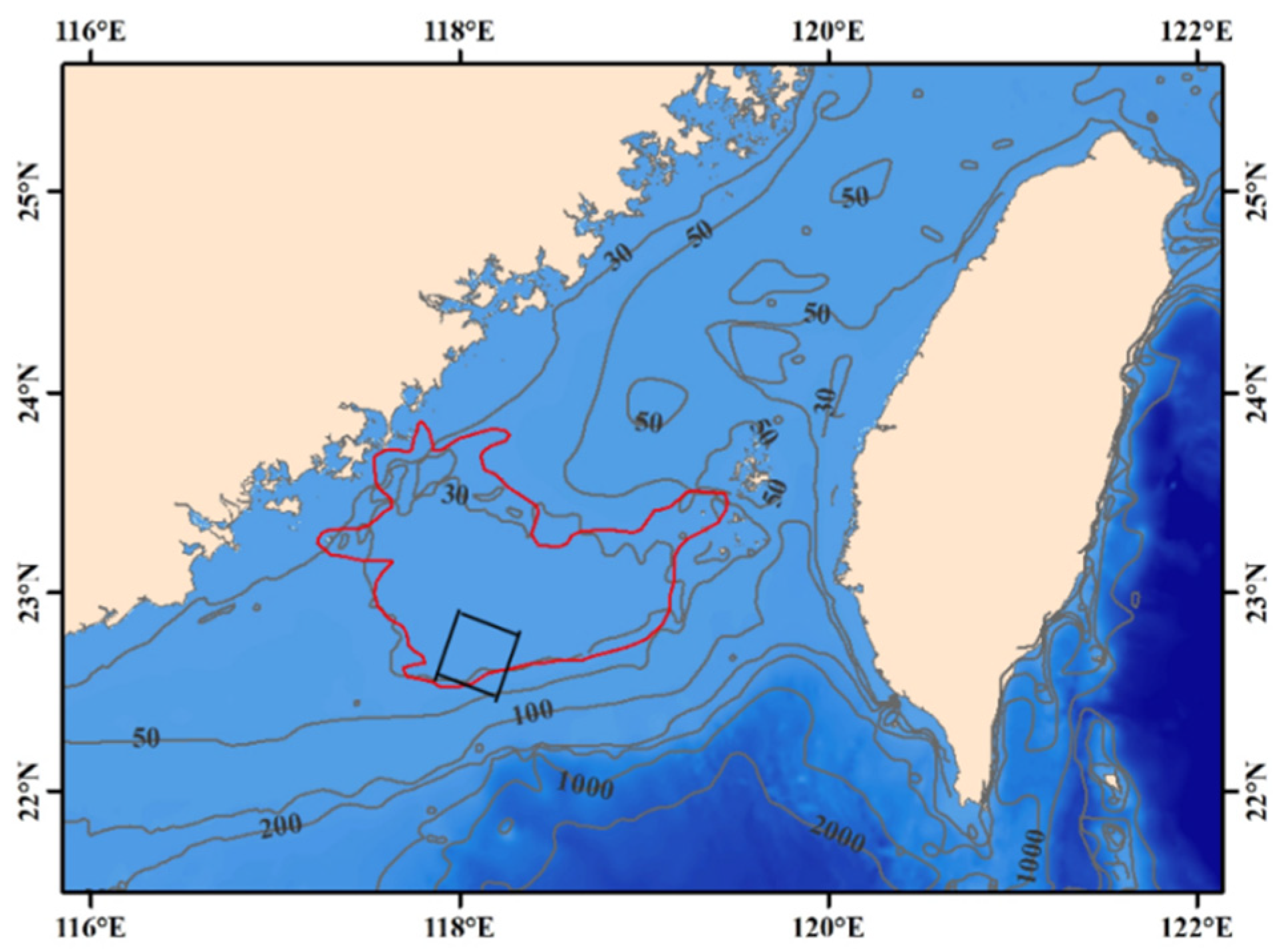




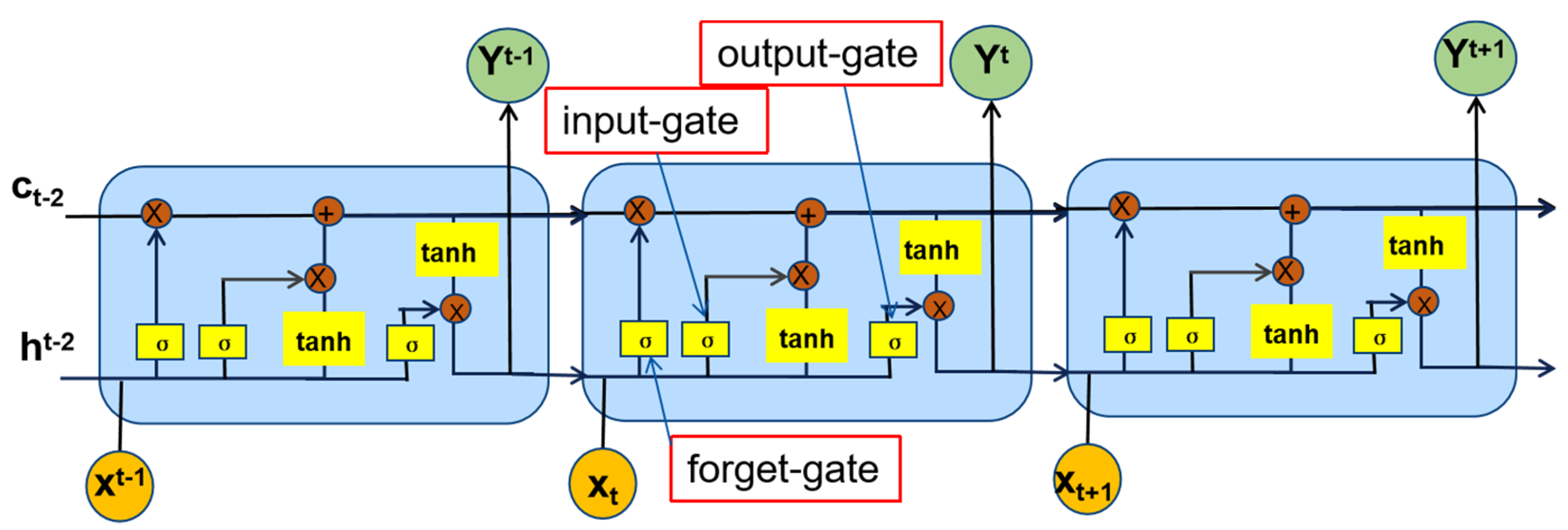

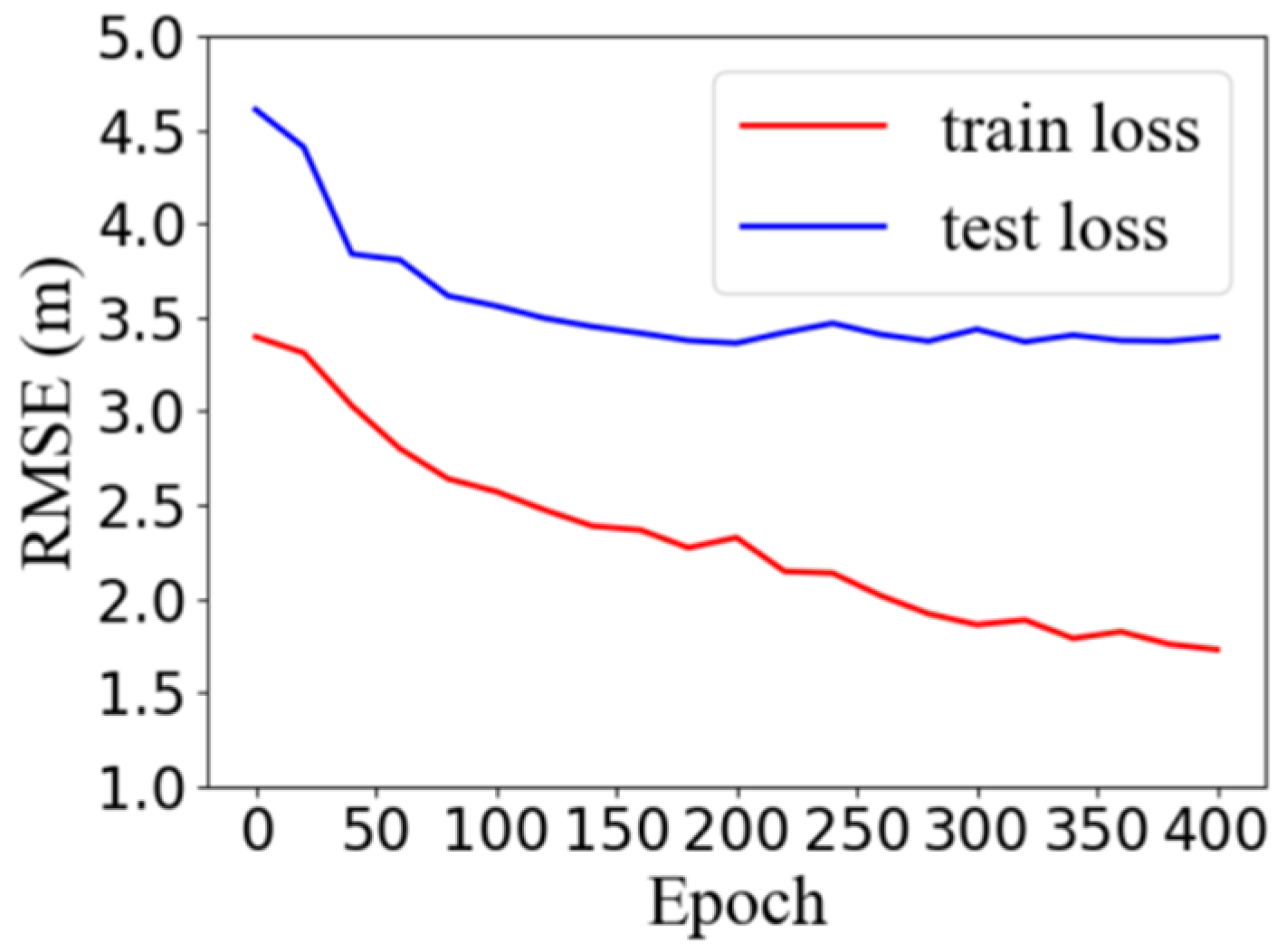
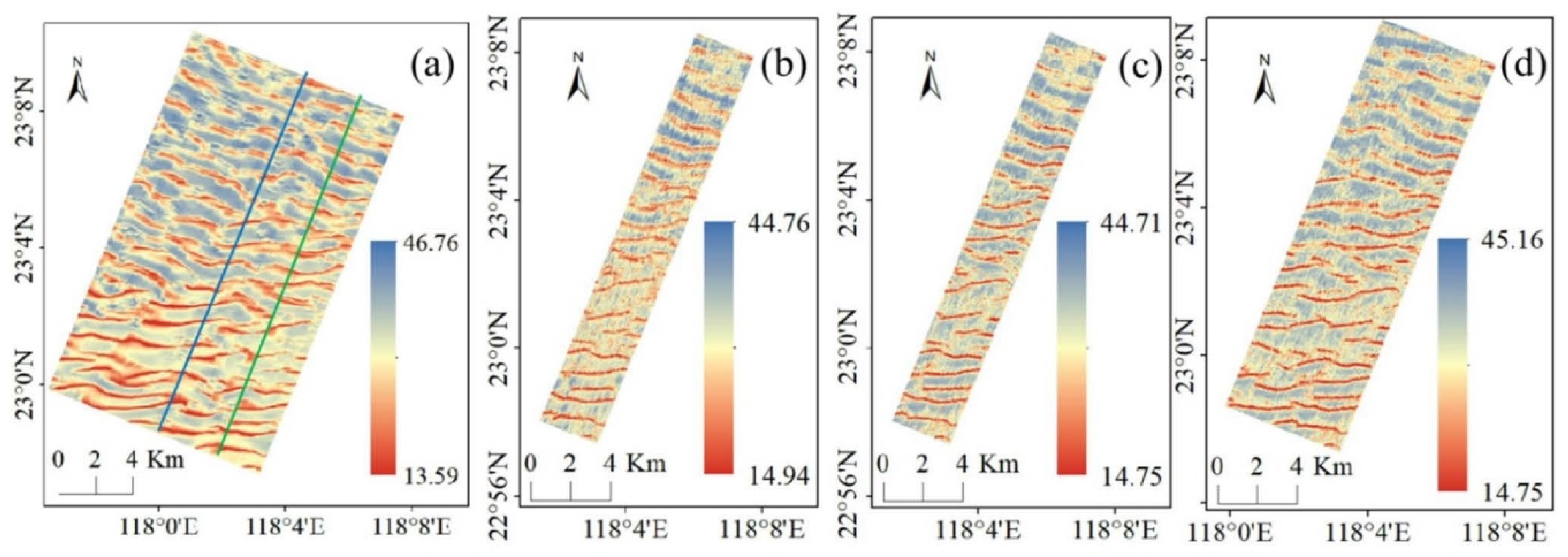


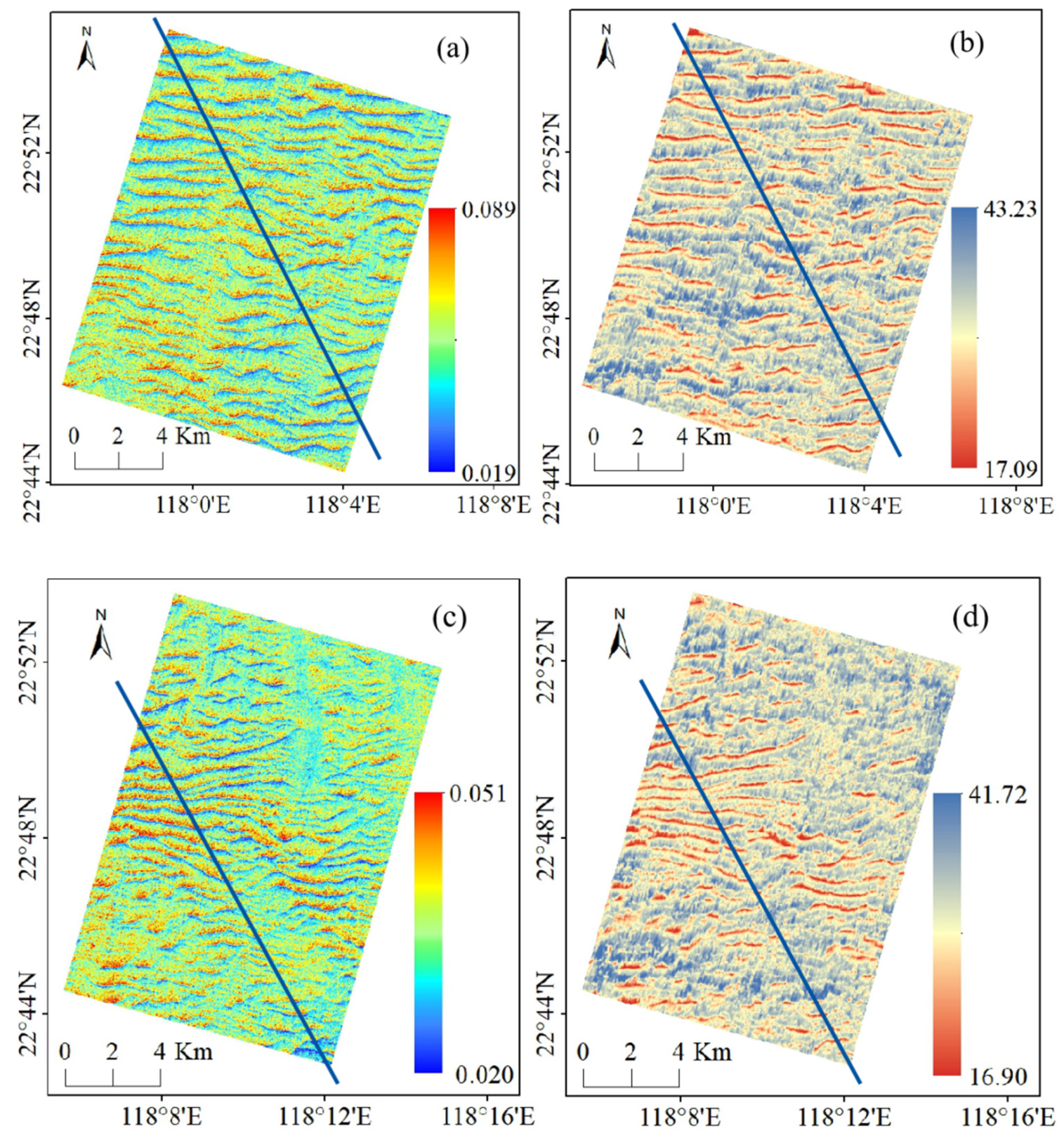

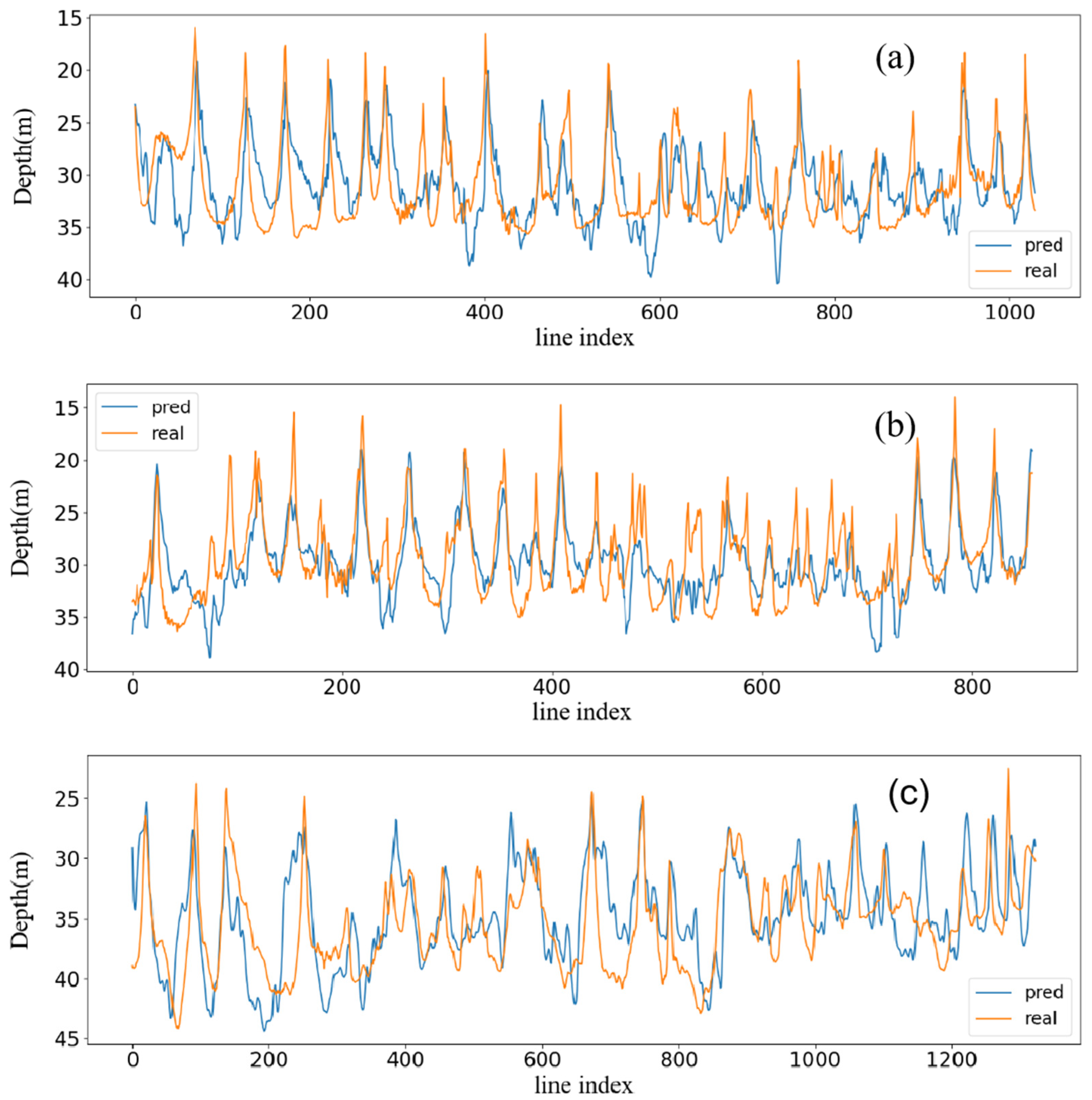


| Model I | Model II | Model III | |
|---|---|---|---|
| Mean absolute error (m) | 2.63 | 2.72 | 2.79 |
| Root mean square error (m) | 3.36 | 3.45 | 3.59 |
| Region A2 | Region A3 | Region A4 | |
|---|---|---|---|
| Mean absolute error (m) | 2.90 | 2.56 | 2.73 |
| Root mean square error (m) | 3.67 | 3.31 | 3.46 |
| Area size (km2) | 224 | 202 | 348 |
| Inversion Region | RMSE (m) at Different Depths | |||
|---|---|---|---|---|
| <27 m | 27–33 m | >33 m | Total | |
| A2 | 5.00 | 3.55 | 3.28 | 3.67 |
| A3 | 4.14 | 2.57 | 3.88 | 3.31 |
| A4 | 4.55 | 3.36 | 3.41 | 3.46 |
| Total | 4.42 | 3.10 | 3.47 | |
| Inversion Region | RMSE (m) at Different Wavelengths | |||
|---|---|---|---|---|
| <200 m | 200–500 m | >500 m | Total | |
| A2 | 3.13 | 4.24 | 5.10 | 3.67 |
| A3 | 3.19 | 3.22 | 3.58 | 3.31 |
| A4 | 3.26 | 3.28 | 4.41 | 3.46 |
| Total | 3.18 | 3.62 | 4.46 | |
| Inversion Region | Accuracy under Differently Sized Training Sets RMSE (m) | |||
|---|---|---|---|---|
| Region A1 | 75% of Region A1 | 50% of Region A1 | 25% of Region A1 | |
| Size (km2) | 255 | 192 | 128 | 64 |
| A2 | 3.67 | 3.89 | 4.55 | 5.01 |
| A3 | 3.31 | 3.52 | 4.10 | 4.71 |
| A4 | 3.46 | 3.72 | 3.91 | 4.45 |
Publisher’s Note: MDPI stays neutral with regard to jurisdictional claims in published maps and institutional affiliations. |
© 2021 by the authors. Licensee MDPI, Basel, Switzerland. This article is an open access article distributed under the terms and conditions of the Creative Commons Attribution (CC BY) license (https://creativecommons.org/licenses/by/4.0/).
Share and Cite
Zhao, Y.; Zhao, L.; Zhang, H.; Fu, B. LSTM-Based Remote Sensing Inversion of Largescale Sand Wave Topography of the Taiwan Banks. Remote Sens. 2021, 13, 3313. https://0-doi-org.brum.beds.ac.uk/10.3390/rs13163313
Zhao Y, Zhao L, Zhang H, Fu B. LSTM-Based Remote Sensing Inversion of Largescale Sand Wave Topography of the Taiwan Banks. Remote Sensing. 2021; 13(16):3313. https://0-doi-org.brum.beds.ac.uk/10.3390/rs13163313
Chicago/Turabian StyleZhao, Yujin, Liaoying Zhao, Huaguo Zhang, and Bin Fu. 2021. "LSTM-Based Remote Sensing Inversion of Largescale Sand Wave Topography of the Taiwan Banks" Remote Sensing 13, no. 16: 3313. https://0-doi-org.brum.beds.ac.uk/10.3390/rs13163313





